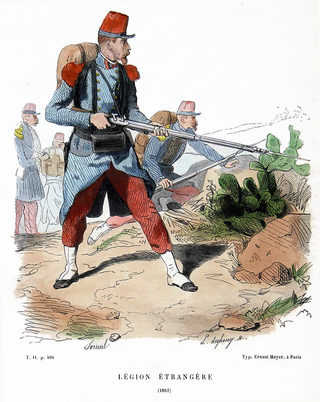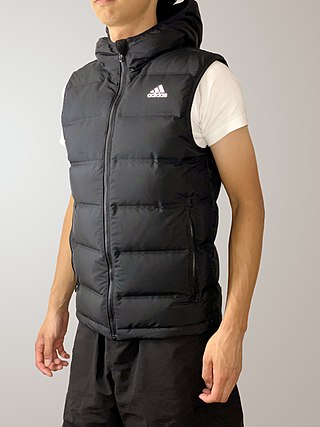
Algeria, officially the People's Democratic Republic of Algeria, is a country in the Maghreb region of North Africa. It is bordered to the northeast by Tunisia; to the east by Libya; to the southeast by Niger; to the southwest by Mali, Mauritania, and Western Sahara; to the west by Morocco; and to the north by the Mediterranean Sea. The capital and largest city is Algiers, located in the far north on the Mediterranean coast.

A waistcoat or vest is a sleeveless upper-body garment. It is usually worn over a dress shirt and necktie and below a coat as a part of most men's formal wear. It is also sported as the third piece in the traditional three-piece male suit. Any given waistcoat can be simple or ornate, or for leisure or luxury. Historically, the waistcoat can be worn either in the place of, or underneath, a larger coat, dependent upon the weather, wearer, and setting.

White tie, also called full evening dress or a dress suit, is the most formal evening Western dress code. For men, it consists of a black tail coat worn over a white dress shirt with a starched or pique bib, white piqué waistcoat and the white bow tie worn around a standing wing collar. Mid or high-waisted black trousers with galon, a braid of trim consisting of two silk stripes to conceal the outer seams of the trousers, along with court shoes complete the outfit. Orders, decorations and medals may be worn. Acceptable accessories include a black top hat, white gloves, a white scarf, a pocket watch, a white pocket square, and a boutonnière. Women wear full-length ball or evening gowns with evening gloves and, optionally, tiaras, jewellery, and a small handbag.

A kaftan or caftan is a variant of the robe or tunic. Originating in Asia, it has been worn by a number of cultures around the world for thousands of years. In Russian usage, kaftan instead refers to a style of men's long suit with tight sleeves.

The Algerian Football Federation (AFF); is the governing body of football in Algeria. Formed in 1962 and was based in the capital Algiers. It has jurisdiction on the Algerian football league system and is in charge of the men's and women's national teams. Although an unofficial national team had played fixtures since 1958, the first recognized international took place in January 1963, some six months after independence. In 2021, twenty structures were added to the Algerian Football Federation. The Algerian Football Federation is considered a member of FIFA.

A casquette d'Afrique was a type of lightweight military headgear generally used by the French metropolitan and colonial armies from the early 1830s to the 1860s.

Fashion in the years 1750–1775 in European countries and the colonial Americas was characterised by greater abundance, elaboration and intricacy in clothing designs, loved by the Rococo artistic trends of the period. The French and English styles of fashion were very different from one another. French style was defined by elaborate court dress, colourful and rich in decoration, worn by such iconic fashion figures as Marie Antoinette.

The Catholic Church in Algeria is part of the worldwide Catholic Church, under the spiritual leadership of the Pope in Rome.

A gilet or body warmer is a sleeveless jacket resembling a waistcoat or blouse. It may be waist- to knee-length and is typically straight-sided rather than fitted; however, historically, gilets were fitted and embroidered. In 19th-century dressmaking a gilet was a dress bodice shaped like a man's waistcoat.

Surtout was a kind of overcoat. A "surtout" was a 17th-century term used to describe a coat worn over another coat, like a waistcoat. Surtout was a new name for it; prior to 1684, it was known as "Suravit" on account of Surhabit (overcoat).

The hand-in-waistcoat is a gesture commonly found in portraiture during the 18th and 19th centuries. The pose appeared by the 1750s to indicate leadership in a calm and firm manner, or allegiance to Freemasonry. The pose is most often associated with Napoleon Bonaparte due to its use in several portraits made by his artist, Jacques-Louis David, amongst them the 1812 painting Napoleon in His Study. The pose, thought of as being stately, was copied by other portrait painters across Europe and America. Most paintings and photographs show the right hand inserted into the waistcoat/jacket, but some sitters appear with the left hand inserted. The pose was also often seen in mid-nineteenth century photography.

Lampas is a type of luxury fabric with a background weft typically in taffeta with supplementary wefts laid on top and forming a design, sometimes also with a "brocading weft". Lampas is typically woven in silk, and often has gold and silver thread enrichment.
Algerian Jewish Sign Language (AJSL), also known as Ghardaia Sign Language, is a moribund village sign language originally of Ghardaïa, Algeria that is now used in Israel and possibly also in France.
The military ranks of Algeria are the military insignia used by the Algerian People's National Army. Being a former colony of France, Algeria shares a similar rank structure to that of France.

The chedda of Tlemcen is a traditional Algerian dress, more precisely of the city of Tlemcen, but also worn in the west of the country, in particular in Oran and Mostaganem. A product of the local craftsmanship, it is worn by brides in Tlemcen for their wedding ceremony.

The Karakou is a long-sleeved fitted velvet jacket embroidered with golden and silvered threads, it is a traditional Algerian garment originating from Algiers.

The Ghlila is a traditional Algerian jacket originating from Algeria, it is a trapezoidal jacket in velvet or brocade with a deep oval neckline, decorative buttons and enriched with embroidery notably featuring golden threads.

The Bniqa is an embroidered shower cap that originated in Algiers.

The Sarma or Serma is a cone-shaped metallic headdress that originated in Algiers.

The M'laya is a black veil that covers the whole body, it originated in Algeria.


















